Abstract
From a modelling viewpoint MEMS are very complex structures. The development of full mathematical models is an extremely challenging problem. Some of the methods, assumptions and simplifications commonly used when modelling macroengineering structures may not be applied to real MEMS. Furthermore applying well-known behavioural models developed for macrostructures to microdevices has proved to be questionable if not inappropriate. Thus alternative approaches need to be used and new models need to be developed. This paper presents mathematical models of mechanical behaviour of micromachined cantilevers and beams on supports under uniform or concentrated load. The models were extracted from finite element simulation data using dimensional analysis.
Similar content being viewed by others
References
M. Gere and S. Timoshenko, Mechanics of Materials. PWS-Kent: Boston, 1990.
S. Timoshenko and Woinowsky-Krieger, Theory of Plates and Shells. Mc Graw-Hill: New York, 1959.
D. Peters, St. Bechtold, and R. Laur, “Optimised behavioural model of a pressure sensor including the touch-down effect,” in Proc. Conf. Model. Simul. Microsystems, Puerto Rico, vol. 1, 1999, pp. 237–240.
Kui Yao and Kenji Uchino, “Analysis on a composite cantilever beam coupling a piezoelectric bimorph to an elastic beam.” Sensors and Actuators A, vol. 89, pp. 215–221, 2001.
B.D. Jensen, F. Bitsie, and M. de Boer, “Interferometric measurement for improved understanding of boundary effects in micromachined beams,” in Proc. SPIE Micromachining and Microfabrication, Santa Clara, USA, 1999.
S. Greek and N. Chitica, “Deflection of surface-micromachined devices due to internal, homogeneous or gradient stresses.” Sensors and Actuators, vol. 78, pp. 1–7, 1999.
Fugian Yang, “Contact deformation of a micromechanical structure.” J. Micromech. Microeng., vol. 14, pp. 263–268, 2004.
J.A. Knapp and M. de Boer, “Mechanics of microcantilever beams subject to combined electrostatic and adhesive forces.” J. Microelectromechanical Syst., vol. 11, no. 6, pp. 754–769, 2002.
M. Ashhab, M. Salapaka, M. Dahleh, and I. Mezic, “Dynamical analysis and control of microcantilevers.” Automatica, vol. 35, pp. 1663–1670, 1999.
C. Doring, T. Grauer, J. Marek, Mettner, H.-P. Trah, and M. Willnann, “Micromachined thermoelectrostatically driven cantilever structures for fluid jet deflection,” Microelctromechanical Systems’92, Travemunde, Germany, 1992, pp. 12–18.
Scaning Probe Microscopy, Basic Concepts and Applications. Phantoms report. Sept. 2003. Published by Phantoms. www.phantomsnet.com.
R. Bashir, J.Z. Hilt, O. Elibol, A. Gupta, and N.A. Peppas, “Micromechanical cantilever as an ultrasensitive pH microsensor,” Appl. Phys. Letters, vol. 81, no. 16, pp. 3091–3093, 2002.
A.-R.A. Khaled, K. Vafai, M. Yang, X. Zhang and C.S. Ozkan, “Analysis, control and augmentation of microcantilever deflections in bio-sensing systems.” Sensors and Actuators, vol. B94, pp. 103–115, 2003.
S. Ertl, M. Adamschik, P. Schmid, P. Gluche, A. Floter, and E. Kohn, “Surface micromachined diamond microswitch.” Diamond and Related Materials, vol. 9, pp. 970–974, 2000.
M. Lishchynska, N. Cordero and O. Slattery, “State of the art in prediction of mechanical behaviour of microsystems,” in Proc. EuroSimE 2004, Brussels, Belgium, 2004.
M.S. Zarnik, K.P. Friedel, A. Wymyslowski, and D. Belavic, “Experimental verification of the finite-element model of a thick-film ceramic sensor,” in Proc. EuroSIME2003, Kluwer, Aix en Provence, 2003.
CoventorWare version 2001.3. Reference Guides and Tutorials.
P. P. Benham, R. J. Crawford and C. G. Armstrong, Mechanics of Engineering Materials. Pearson: Essex, 1996.
Q. Meng, M. Mehregany, and R.L. Mullen, “Theoretical modeling of microfabricated beams with elastically restrained supports.” J. Microelectromech. Syst., vol. 2, no. 3, pp. 128–137, 1993.
Author information
Authors and Affiliations
Corresponding author
Additional information
Maryna Lishchynska received a M.Sc. in Applied mathematics from Lviv Polytechnic State University, Ukraine in 1993, and was awarded Ph.D. in Technical Sciences from the Institute of Physics and Mechanics of the National Academy of Sciences of Ukraine in 2000. Dr. Lishchynska’s Ph.D. research was in the area of deformable solid mechanics (fatigue fracture mechanics). During 1993–2001 she worked as a research scientist on fracture mechanics problems for the Institute of Physics and Mechanics of the National Academy of Sciences of Ukraine and published a range of papers. Maryna joined the Tyndall National Institute (Cork, Ireland) in 2003 as a post-doctoral researcher in the Computational Modelling Group. She is currently involved in development of behavioural models of microsystems structures.
Nicolas Cordero received Ing. Superior de Telecomunicación at Polytechnical University of Madrid. He is at Tyndal National Institute (Cork, Ireland) since 1990. Here he has worked on numerical modelling of electronic and optoelectronic devices based on compound semiconductors (MESFETs, HEMTs, Schottky diodes, Lasers and LEDs). He has also worked on modelling of photo-voltaic (PV) systems. Since 2001 Nicolas is at the Computational Modelling Group working on thermal and thermo-mechanical modelling, including finite element modelling of MEMS.
Orla Slattery obtained a B.E. in civil engineering from University College Cork in 1989, M.Eng.Sc (civil engineering) in 1991 and M.Eng.Sc (electronics) 1998. In 1991 she joined the Interconnection and Packaging Group at NMRC where she was responsible for simulation and characterisation of thermal and thermomechanical issues in electronics components and systems. Since 1999 she has been working as a research scientist with the Computational Modelling Group in NMRC. She has participated in a number of European Union and Irish Government funded projects as well as providing services to Irish and European Industry. Her current research interests include the application of computational simulation tools to the solution of thermal and thermomechanical problems in microelectronics components and systems. She has published a range of papers in these areas. She is also involved in modelling and simulation of MEMS and is currently vice-chair of the EU funded Network of Excellence on Design for Micro and Nano manufacture, PATENT- DfMM.
Rights and permissions
About this article
Cite this article
Lishchynska, M., Cordero, N. & Slattery, O. Development of Behavioural Models for Mechanically Loaded Microcantilevers and Beams. Analog Integr Circ Sig Process 44, 109–118 (2005). https://doi.org/10.1007/s10470-005-2590-1
Issue Date:
DOI: https://doi.org/10.1007/s10470-005-2590-1




